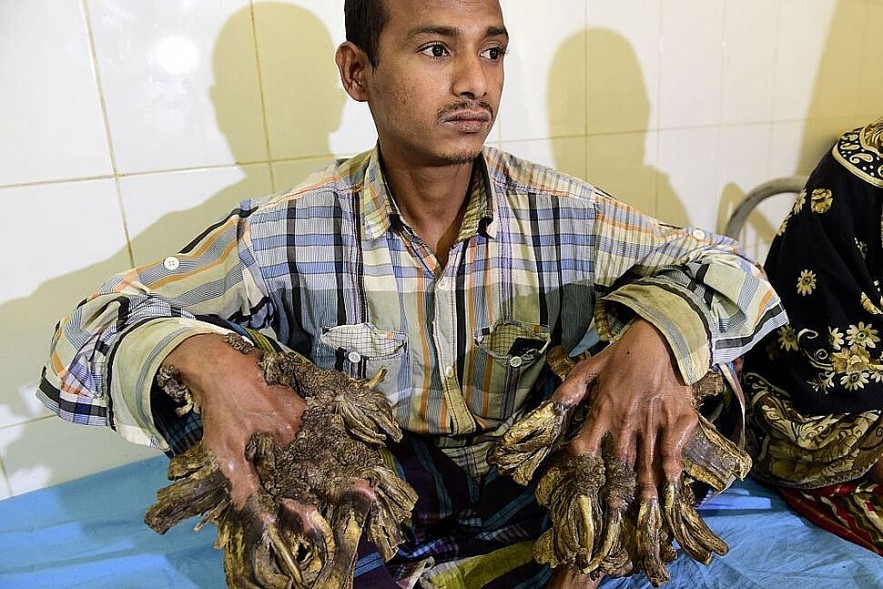Top 20 Rarest Diseases That Can't Explain In the World
 Top 10 Common Diseases In the World That Have the Highest Mortality Rate Top 10 Common Diseases In the World That Have the Highest Mortality Rate |
 Top 9 Common Diseases in Winter and Tips to Prevent Top 9 Common Diseases in Winter and Tips to Prevent |
 |
| Exploding head syndrome - Rarest Diseases in the World |
1.Exploding head syndrome
This is a syndrome that affects thousands of people all over the world, with the primary manifestation being the sensation that one's head is about to explode while one is getting ready to go to sleep, despite there being no warning signs whatsoever.
Although patients over the age of 50 make up the vast majority of those diagnosed with this syndrome, the condition can also manifest in younger patients.
2.Alice in Wonderland Syndrome
The main symptoms of this syndrome include hallucinations, disorientation, loss of sense of self, visions of flying miracles, and other strange experiences. It is common in children and adolescents and does not necessarily require any special treatment as it can go away on its own. A number of the cases have been connected to the consumption of psychoactive substances, such as amphetamines.
3.Necrotizing fasciitis
This extremely uncommon condition, which is also known as flesh-eating disease, is brought on by a number of distinct kinds of bacteria, one of which is group A streptococcus. One of the symptoms of this condition is cellulitis that gets progressively worse over time. It has a mortality rate of over 70 percent and can result in death in as little as twenty-four hours. Moreover, it can cause death in as little as twenty-four hours.
4.Menkes disease
The illness is caused by inaccuracies in a person's genetic makeup and manifests itself more frequently in men than in women. Symptoms such as blurred vision, weakness in the muscles, convulsions, and other similar manifestations are brought on by copper deficiency in the body. The treatment consists primarily of taking copper supplements in addition to a variety of other measures that are supportive.
5.Cotard delution
The individual suffering from this delusion frequently has the impression that he has passed away. There are a significant number of individuals who suffer from Cotard hallucinations and are treated with medication or dialysis to eliminate factor 9-carboxymethoxymethylguanine (CMMG).
6.Tree man syndrome (Epidermodysplasia verruciformis)
 |
| 'Tree Man' From Bangladesh |
The virus in question is a member of the human papillomavirus (HPV) family, and it is the one responsible for causing the disease. Lesions are lumpy, bark-like growths that can appear anywhere on the body, including the face and extremities. Although the disease does not result in death, it has a significant negative impact on the patient's appearance and severely disrupts their normal activities. At this time, the only treatment available is to cut off the "twigs" when they become excessively long and rapid in their growth.
7.The Stone Man Syndrome (Fibrodysplasia Ossificans Progressiva)
Gene mutations cause progressive fibrosis, which is the calcification of the connective tissue throughout the entire body. This calcification causes the body to become rigid and contorted, much like a living statue. At the moment, there is no treatment that is proven to be effective for this disease.
8.Polydactylism
Polydactyly is a condition in which a person has more than 10 fingers or toes; however, the extra toes that are present are typically boneless and consist only of soft tissue (skin, muscle, connective tissue). This condition affects the birth of approximately one baby out of every 500 on average. The treatment consists only of the surgical amputation of the extra fingers.
9.Darkening of the skin due to silver (argyria)
The disease is brought on by prolonged contact with chemical compounds containing silver, which causes the color of the body's skin to change to a bluish or grayish hue over time. Both the disease and the laser treatment have the potential to be fatal in some patients.
10.Proteus syndrome
This condition, which is also referred to as Wiedemann syndrome, is distinguished by abnormal bone and skin hyperplasia, which ultimately leads to abnormally shaped hands and feet. Research and development are still being done on various treatment modalities.
11.Werewolf Syndrome
Uncontrolled hair growth can result in long, dense hair growth on the entire body or in certain parts of the body, such as the face, hands, and back, if genetic abnormalities are present. Uncontrolled hair growth can occur on any part of the body. This is a very uncommon disease, and there have only been about 50 cases recorded across the world.
12.Porphyria
A genetic or acquired disease, porphyria is characterized by disorders of the production of porphyrins and the heme chain in red blood cells. Porphyria can be passed down through families. This disease frequently causes symptoms such as abdominal pain, vomiting, and neuropsychiatric disorders.
13.Lion face syndrome
The patient's face takes on the appearance of a lion's face as a result of the uncontrolled growth of the craniofacial bone. Loss of vision is the comorbid condition that occurs most frequently (due to compression of the optic nerve by bone).
14.Progenia (geriatric condition)
The condition known as progeria can also be referred to as the disease of aging, senility, or premature aging. According to the available data, this disease is extremely uncommon, and there are currently only about 80 cases reported anywhere in the world.
15.Hailey-Hailey Disease
The disease appears after puberty with blistering, inflammatory skin lesions similar to allergies. There is currently no specific treatment.
16.Cronkhite-Canada Syndrome
It is a rare syndrome that can manifest itself in a number of different ways, including a loss of taste, intestinal polyps, hair loss, and dysplasia of the nails. There have been approximately 500 cases of this syndrome that have been documented.
17.Alien Hand Syndrome
 |
| Alien Hand Syndrome |
Also known as the "alien hand". People with this syndrome have a feeling that they can't control their hands, their hands are not theirs, so they have meaningless and unwanted activities.
18.Lymphatic Filariasis
As a result of the obstruction that filariasis causes in the lymphatic system, the patient will develop edematous lower extremities that will eventually grow to the size of an elephant's foot, which will make it difficult for them to walk. As necessary, treat with antihelmintics or undergo surgery.
19.Parry-Romberg syndrome
The main symptom of this syndrome, which has an unknown root cause, is atrophy of the muscle and skin on one side of the patient's face. This causes the patient's face to appear concave on one side, unbalanced, and unattractive. At this time, there is no treatment that is proven to be effective.
20.Lamprey's disease
Lesions on the body, particularly in the eyes, can appear to resemble yellow jackfruit spines or the mouth of an open eel, complete with jagged teeth and a deep throat. This illness is likely the most terrifying of all those that can cause these symptoms. hoot. It is not known what causes the disease or how it can be treated.
 14 Most Common Andrological Diseases That Every Man Should Know 14 Most Common Andrological Diseases That Every Man Should Know Learning about andrological diseases is essential for men to detect and treat promptly, helping to limit complications later, according to andrologists. |
 Is Pain A Disease or A Symptom of Disease? Is Pain A Disease or A Symptom of Disease? Countless people live with the burden of chronic pain. Is Pain A Disease or A Symptom of Disease? |























